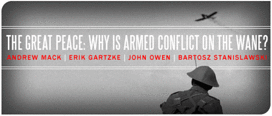Lead Essay
Andrew Mack outlines a dramatic decline over the last several decades in the number of battlefield deaths and of wars overall. Reason, he argues, for cautious optimism. He reviews several arguments for why this decline has taken place. He dismisses the “nuclear peace” theory, noting that the world’s nuclear powers have been involved in many wars. He suggests that several other things may be driving the trend. First, democracies tend not to fight one another, and there are more democracies now. Second, the gains that nations realize from international trade now far exceed those they could otherwise realize through plunder. In our era, conquest doesn’t pay like it used to. International support of insurgent groups shriveled after the Cold War. And International peacekeeping institutions grew. Mack argues that while each has its partisans, these explanations are not mutually exclusive.
Response Essays
Erik Gartzke argues that modern states have engaged in fewer and less deadly wars because it is now very often more profitable to trade than to plunder. The wave of midcentury wars had two causes; these wars were often either anticolonial conflicts, in which the great powers effectively surrendered their strategies of plunder, or ideological proxy conflicts stemming from the Cold War (or, of course, a mixture of both). Yet neither cause obtains much anymore. Today’s wars tend to be between poorer, less militarily capable countries, with the great powers acting in a policing role. Whether this trend continues will depend to a great extent on the trajectory of the economically rising east Asian states.
John Owen agrees that both democratic peace theory and commercial peace theory have some explanatory power, and that both of them may be working in tandem right now. But what started the virtuous circle? Is there a deeper explanation? Owen suggests that U.S. hegemony is that underlying factor. Hegemonic peace theory is distasteful to many, in that it claims one nation must be richer and more powerful than the rest to set the world at peace. Though distasteful, it might still be correct; if so, we should not welcome the decline of American hegemony.
Bartosz Stanislawski offers a mixed assessment of today’s human security picture. Although wars have become fewer and less deadly, past performance is not necessarily indicative of future results. Nonstate actors are of particular concern today, in that, while states’ behavior may be modeled rationally, groups with an eccentric ideological or religious motivation cannot be so modeled. The result, obviously, is insecurity. The role of the mass media is also important, in his view. While much progress has been made, and while that progress is underreported, the media tend strongly to report violent conflict in a way that fills up the 24-hour news cycle. The result can be unjustified pessimism. Neither it nor its counterpart, unjustified optimism, is warranted.

